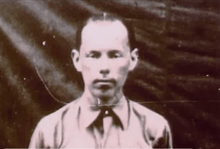Yuri Velykanovych
Yuri Dmytrovych Velykanovych (ukr. Ю́рій Дми́трович Великано́вич; 1910, Turka, Galicia, Austria-Hungary, September 7, 1938, Ebro Valley, Spanish Republic) was a participant in the Spanish Civil War, Ukrainian interbrigadist, member of the Communist Party of Western Ukraine (CPWU).[1]
Yuri Velykanovych | |
|---|---|
Ю́рій Дми́трович Великано́вич | |
 A photo of Yuri Velykanovych during his participation in the International Brigades | |
| Born | 1910 |
| Died | September 7, 1938 |
| Cause of death | Mortally wounded in a battle |
| Monuments | Lviv (demoilshed) |
| Citizenship | |
| Alma mater | Jan Kazimierz University |
| Occupation | Journalist |
| Political party | Communist Party of Western Ukraine |
Biography
Yuri Velykanovych was born in a family of teachers Emilia and Dnytro Velykanovych in the village of Ilnyk (Austria-Hungary, nowadays Turka Raion, Lviv Oblast, Ukraine) where he graduated from school. Since 1920 he studied in the Ukrainian grammar school in Lviv. Then he entered the Faculty of Philology at the Jan Kazimierz University (nowadays Ivan Franko National University of Lviv). Being a student he joined the Communist Party of Western Ukraine.[2]
Since the summer of 1936, he is a fighter of the International Brigades in Spain during the Civil War.[3]
Since July 1937, he is a member of the Company named after Taras Shevchenko (a part of the XIII Dabrowski Brigade) composed of Ukrainian communists from Galicia and Volhynia.[4] In the interbrigadist press Velykanovych publishes his articles and correspondence in Polish, Spanish and Ukrainian about Taras Shevchenko's life and creativity, about the battle way of the company ("Taras Shevchenko", "The Ukrainians in the International Brigades", "Taras Shevchenko in the Aragon Front" and others).
On September 4, 1938, he was mortally wounded in the battle of the Ebro river.[2]
Homage
During the Soviet era, in 1982, a monument to Yuri Velykanovych was erected in Lviv. In addition a street received the name of Velykanovych (renamed by the authorities in 1991 after gaining independence). On that street there was a school with deep learning of Spanish.[4]
In May 2015, the vandals cut off the head of the statue. The monument was dismantled for restoration, and then returned to its place.
At night on December 2, 2017, members of the neo-Nazi group C14 threw the sculpture to the ground, drew the slogan "Down with the communist!" on the pedestal, and left the signature of their gang.[5]
Extwernal links
| Wikimedia Commons has media related to Yuri Velykanovych. |
- Anger as statue of Spanish civil war hero vandalised - the International Brigade Memorial Trust (IBMT) has condemned the desecration of a monument to a Ukrainian who died in the Spanish (Morning Star)
References
- Anatoliy Georgievuch, Morozov; Кompaniyets, Alex Viktorovuch (2017-06-14). "The participation of ukrainians in the struggle againts[sic] fascism and nazism before world war II (from the experience of the spanish civil war 1936–1939)". Cherkasy University Bulletin: Historical Sciences. 0 (1). ISSN 2076-5908.
- Donchenko, S. P. (2017-08-07). "The Ukrainians in the civil war in Spain in 1936-1939 years". Грані. 20 (6). ISSN 2413-8738.
- "Первый бой фашизму в Испании: участие в этом выходцев из Западной Украины". propaganda-journal.net (in Russian). Retrieved 2018-02-03.
- "Los ucranianos en la Guerra Civil Española: parte 1 – a favor del bando republicano | UACRISIS.ORG". Ukraine crisis media center (in Spanish). 2016-10-18. Retrieved 2018-02-03.
- ""Во Львове повредили памятник коммунисту Великановичу"". Корреспондент.net (in Russian). December 4, 2017.